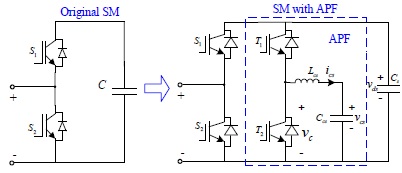- ALL COMPUTER, ELECTRONICS AND MECHANICAL COURSES AVAILABLE…. PROJECT GUIDANCE SINCE 2004. FOR FURTHER DETAILS CALL 9443117328


Projects > ELECTRICAL > 2017 > IEEE > POWER ELECTRONICS
The modular multilevel converter (MMC) is receiving wide acceptance in both high- and medium-voltage applications. However, due to the low (fundamental and second-order) frequency ripple powers in the submodule (SM) capacitors, large capacitance is required to smooth the SM voltage. The SM capacitors account for a large portion of volume and weight in MMC system. Present methods (e.g. circulating current control, power channels linking upper and lower arms) cannot eliminate the fundamental and second-order ripple powers simultaneously. This paper investigates the feasibility of an active power decoupling technique for solving this issue. By adding a buck-type active power filter (APF) circuit (which contains another energy-storage capacitor), the low-frequency ripple powers can be transferred to the APF capacitor. This significantly reduces the SM voltage ripple and therefore the total capacitance of the submodule. To enhance voltage ripple suppression, APF capacitor voltage reference is modified in a closed-loop manner, and a proportional-integral plus repetitive controller is proposed. Simulations and experimental results prove the validity of the method. A comparison with traditional MMC shows that it can significantly reduce system volume and improve power density. The method is best suited for MV applications where power density is given a high priority.
HVDC Modular Multilevel Converter.
Low frequency ripple power in the submodules (SM) of the modular multilevel converter (MMC) makes the SM capacitors (and therefore the MMC system) bulky and heavy. This paper proposed an active power decoupling method to address this problem. It introduces a buck-type APF circuit into the half-bridge SM, and uses an auxiliary capacitor for ripple energy storage. An overall control strategy is proposed according to the working principle of the proposed APF SM, in which active damping is used to suppress the LC resonance peak of the APF circuit, and a “PI+Repetitive†control scheme is adopted for APF capacitor voltage control. In addition, closed-loop compensation of the voltage reference is employed to ensure precision active power decoupling in practical applications. Conversely, it reduces the circulating current. Besides, it can suppress the fundamental and second harmonic components of ripple voltage simultaneously (while the injection methods can only get rid of the second-order one), leaving the main SM capacitor with only switching harmonics. The proposed method provides a candidate MMC solution for constant-frequency MV applications where high power density (or limited installation space) is a key concern.
Proposed MMC submodule with active power decoupling
